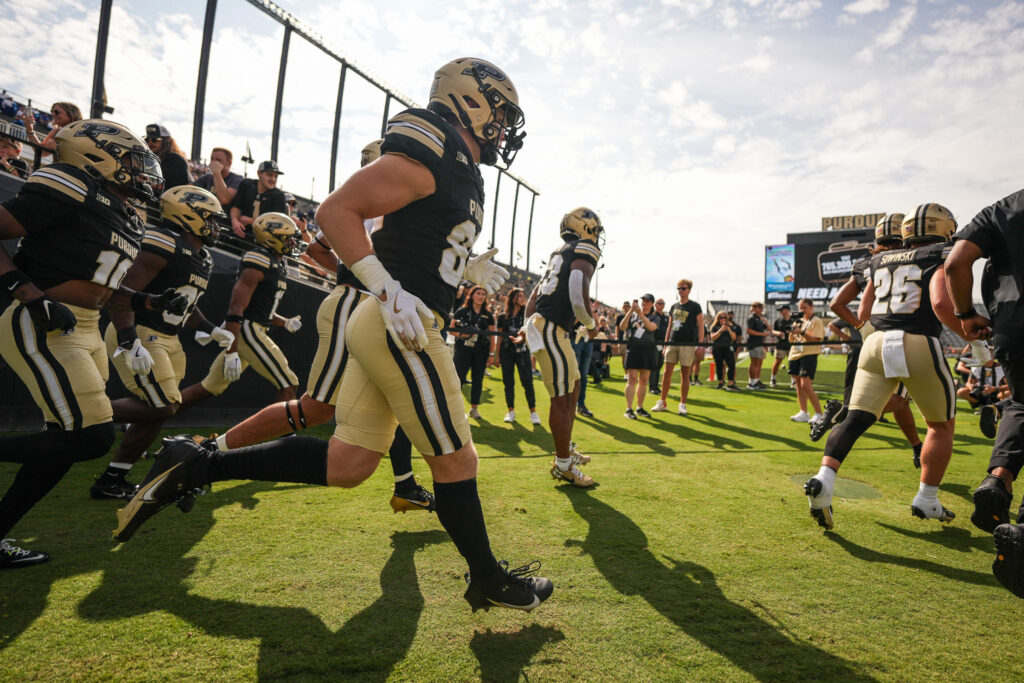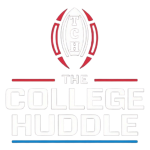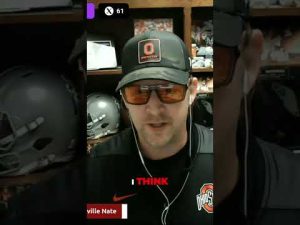
Purdue Football
Week 1 of the 2024 college football season provided insight into the defensive philosophies of Big Ten teams, with blitz-heavy schemes standing out for several programs. Blitzing, where the defense sends extra players beyond the typical pass rushers, can put pressure on opposing quarterbacks and disrupt their rhythm. Here’s a look at the Big Ten teams that blitzed the most in their season openers, ranked by their blitz rate (percentage of opponent drop backs where a blitz occurred), according to PFF.
- Purdue Boilermakers
- Opponent Dropbacks: 15
- Snaps Blitzed: 9
- Blitz Rate: 60.00%
Purdue topped the list in Week 1, bringing the heat on 60% of opponent dropbacks. With 9 blitzes on 15 passing attempts, the Boilermakers sent a clear message that they intend to disrupt passing games this season. Their aggressive approach likely aims to compensate for any gaps in coverage by forcing the quarterback into hurried decisions.
- Michigan Wolverines
- Opponent Dropbacks: 39
- Snaps Blitzed: 23
- Blitz Rate: 58.97%
Michigan, known for its stout defense, employed an aggressive blitz strategy against a pass-heavy opponent. Blitzing on nearly 59% of passing downs, the Wolverines sought to pressure the quarterback with an overwhelming pass rush, showcasing their intent to dominate at the line of scrimmage while challenging opposing offenses to beat them through the air.
- Illinois Fighting Illini
- Opponent Dropbacks: 34
- Snaps Blitzed: 16
- Blitz Rate: 47.06%
Illinois also featured a heavy blitz package, coming in with a blitz rate just under 50%. Their strategy, blitzing on 16 of 34 pass attempts, reflects their focus on creating chaos in the backfield and disrupting timing for opposing quarterbacks. This high-pressure approach could be a central element of their defensive identity this season.
- Minnesota Golden Gophers
- Opponent Dropbacks: 28
- Snaps Blitzed: 13
- Blitz Rate: 46.43%
Minnesota employed an aggressive game plan by blitzing on nearly half of the passing plays they faced. Their 46.43% blitz rate suggests that they are committed to getting after the quarterback and forcing hurried throws, rather than relying solely on coverage to stop the passing game.
- USC Trojans
- Opponent Dropbacks: 38
- Snaps Blitzed: 17
- Blitz Rate: 44.74%
The USC Trojans, now a part of the Big Ten, came in with a 44.74% blitz rate. Sending extra pressure on 17 of 38 passing plays, the Trojans demonstrated a willingness to gamble on bringing more rushers to the line of scrimmage, a strategy that could help them gain an edge in key Big Ten matchups later in the season.
- Washington Huskies
- Opponent Dropbacks: 36
- Snaps Blitzed: 16
- Blitz Rate: 44.44%
Washington, another recent Big Ten affiliate, utilized a similar blitz-heavy strategy to USC. Their 44.44% blitz rate illustrates their desire to challenge opposing quarterbacks by collapsing the pocket and forcing quick decisions under duress.
- Penn State Nittany Lions
- Opponent Dropbacks: 31
- Snaps Blitzed: 12
- Blitz Rate: 38.71%
Penn State took a more moderate but still impactful approach, blitzing on nearly 39% of passing downs. This balance between coverage and pressure speaks to the Nittany Lions’ defensive versatility, blending aggressive playcalling with an ability to cover effectively when needed.
- Oregon Ducks
- Opponent Dropbacks: 32
- Snaps Blitzed: 11
- Blitz Rate: 34.38%
Oregon’s defense mixed in the blitz on just over one-third of passing plays, showing a willingness to turn up the heat when necessary but not overcommitting to pressure. Their approach reflects a more calculated strategy compared to some of the more blitz-happy teams on this list.
- UCLA Bruins
- Opponent Dropbacks: 52
- Snaps Blitzed: 15
- Blitz Rate: 28.85%
Despite facing a significant number of passing attempts, UCLA kept their blitz rate just under 30%. This more conservative approach may suggest a focus on maintaining coverage while selectively sending extra rushers when they saw an opportunity.
- Iowa Hawkeyes
- Opponent Dropbacks: 35
- Snaps Blitzed: 10
- Blitz Rate: 28.57%
- Ohio State Buckeyes
- Opponent Dropbacks: 35
- Snaps Blitzed: 10
- Blitz Rate: 28.57%
Both Iowa and Ohio State blitzed on 28.57% of passing plays. This strategy speaks to a measured approach—neither team went overboard on blitzing but still applied pressure at key moments to keep opposing quarterbacks on their toes.
- Michigan State Spartans
- Opponent Dropbacks: 43
- Snaps Blitzed: 12
- Blitz Rate: 27.91%
Michigan State dialed up the blitz on 12 out of 43 dropbacks, sticking with a blitz rate just below 30%. The Spartans’ defense appeared to prefer relying on their base rush but threw in enough blitzes to keep the offense guessing.
- Wisconsin Badgers
- Opponent Dropbacks: 22
- Snaps Blitzed: 6
- Blitz Rate: 27.27%
Wisconsin, typically known for disciplined and physical defense, brought pressure on just over a quarter of the dropbacks they faced. This strategy suggests a balanced defensive approach, where the Badgers are willing to blitz but not overly reliant on it.
- Indiana Hoosiers
- Opponent Dropbacks: 37
- Snaps Blitzed: 10
- Blitz Rate: 27.03%
Indiana kept a similar approach to Wisconsin and Michigan State, blitzing on just over 27% of passing downs. They mixed in pressure to challenge quarterbacks while maintaining a stronger focus on coverage schemes.
- Rutgers Scarlet Knights
- Opponent Dropbacks: 28
- Snaps Blitzed: 7
- Blitz Rate: 25.00%
Rutgers blitzed on 25% of passing plays in their Week 1 matchup. This more conservative rate shows that they prefer to stay disciplined in coverage but still bring pressure when needed to prevent the quarterback from settling into a rhythm.
- Maryland Terrapins
- Opponent Dropbacks: 35
- Snaps Blitzed: 8
- Blitz Rate: 22.86%
Maryland’s 22.86% blitz rate indicates a cautious approach, relying more on their base defense and fewer blitzes. While still applying pressure, they appear to trust their defensive line and coverage teams to handle most situations without sending extra players.
- Northwestern Wildcats
- Opponent Dropbacks: 42
- Snaps Blitzed: 6
- Blitz Rate: 14.29%
Northwestern was one of the least aggressive blitzing teams in Week 1, bringing pressure on just 14.29% of passing plays. Their focus on coverage could be indicative of a defensive strategy built around minimizing big plays by not risking too much in blitz-heavy situations.
- Nebraska Cornhuskers
- Opponent Dropbacks: 28
- Snaps Blitzed: 0
- Blitz Rate: 0.00%
Nebraska didn’t blitz at all in their season opener, making them the only Big Ten team to avoid sending extra rushers. This could be due to confidence in their front four’s ability to generate pressure or a scheme built around maintaining solid coverage at all times.
Conclusion
Week 1 of Big Ten football saw a range of defensive strategies, from Purdue’s aggressive 60% blitz rate to Nebraska’s complete lack of blitzing. As the season progresses, these approaches will be tested against increasingly complex offenses, and adjustments may be necessary. For now, teams like Purdue and Michigan have established themselves as blitz-heavy squads, while others like Nebraska and Northwestern are taking more conservative routes.




